The Bay Trail Preview: Intel Atom Z3770 Tested
by Anand Lal Shimpi & Brian Klug on September 11, 2013 12:00 PM EST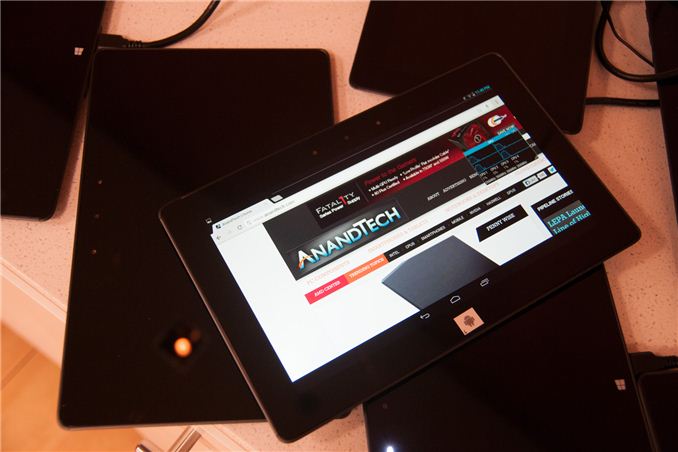
Earlier this year Intel unveiled Silvermont, its first true architectural update to Atom since its introduction in 2008. I won’t rehash Silvermont’s architecture here, but it’s designed to be a true test of Intel’s performance in the ultra mobile space. Leveraging Intel’s first 22nm SoC process and a very low power/efficient microarchitecture, Silvermont aims squarely at the latest Krait cores from Qualcomm and ARM’s Cortex A15.
Today Intel takes the next step forward, introducing the first tablet SoC based on Silvermont: Bay Trail.
Bay Trail takes up to four Silvermont cores, and for the first time in an ultra mobile Intel SoC pairs them with Intel’s own graphics IP. That’s right, rather than using a GPU block from Imagination Technologies, Bay Trail leverages the same GPU architecture as Ivy Bridge.
The first Bay Trail tablets will be shipping by the end of the year, across both Android and Windows 8.1. Intel expects Bay Trail to show up in tablets and 2-in-1s priced below $599, with everything above $599 falling under Haswell’s jurisdiction.
Bay Trail & Branding
Bay Trail, like all Atom platforms before it, will be available in multiple form factors. Unlike the Atoms of yesterday however, the SoC will carry Pentium and Celeron branding when used in notebooks and desktops. Intel didn’t disclose too much about its Silvermont plans in other form factors other than some basic naming:
Basically notebooks ship under the Pentium N3000 & Celeron N2000 series, while desktops will carry Pentium J2000 & Celeron J1000 branding. All Pentium SKUs seem to be quad-core, while Celeron SKUs will be available in both dual and quad-core versions.
Thankfully Intel shied away from introducing the same complexity with its tablet focused Bay Trail parts. All Bay Trail tablet SKUs carry Atom branding. There’s the quad-core Z3700 series and the dual-core Z3600 series.
Although Intel offers both dual and quad-core Bay Trail SKUs, they are both based on the same single physical design. In other words, dual-core Bay Trail parts are just die harvested quad-core parts. Intel isn’t disclosing die size or transistor counts, which is ironic (and disappointing) given that Apple just disclosed both (or at least relative magnitude of one) for its A7 SoC.
Internally, the Bay Trail design is pretty nice. There are either two or four cores enabled, each pair with a shared 1MB L2 cache (2MB total for a quad-core part). Intel is following the unfortunate lead of everyone else in the mobile industry and advertising max turbo frequencies exclusively.
Thankfully Intel hasn’t yet decided to obfuscate max non-turbo frequencies:
| Bay Trail Turbo Speeds | ||||||||
| Z3770 | Z3770D | Z3740 | Z3740D | Z3680 | Z3680D | |||
| Max turbo frequency | 2.39GHz | 2.41GHz | 1.86GHz | 1.83GHz | 2.0GHz | 2.0GHz | ||
| Max non-turbo Frequency | 1.46GHz | 1.5GHz | 1.33GHz | 1.33GHz | 1.33GHz | 1.33GHz | ||
In general you’re looking at 1.33GHz - 1.46GHz max non-turbo frequencies, with Bay Trail being able to turbo up to anywhere between 1.83GHz and 2.40GHz depending on SKU.
Although the core architecture is 64-bit in design, there will be no OS support for 64-bit Bay Trail at launch. Windows 8.1 with Connected Standby appears to still be 32-bit only, and obviously Android is 32-bit only at this point as well.
The memory interface is fairly ridiculous by mobile standards. You either get two 64-bit LPDDR3 channels (128-bit total width) or a single 64-bit DDR3L channel. In the case of the former, that’s the same memory bus width as Apple’s A5X/A6X line of SoCs as well as the standard Core i3/i5/i7 parts. Max supported memory frequency is 1066MHz in dual-channel LPDDR3 mode, or 1333MHz in single-channel DDR3L mode. The only benefit to the latter is really cost, as Bay Trail will purportedly show up in some very cheap devices.
The GPU is Intel’s own Gen7 graphics core, a cut down implementation of what we first saw in Ivy Bridge. I suppose it’s premature to expect Merrifield, Bay Trail’s smartphone counterpart, to also use Intel’s own graphics core but it’s clear this is the direction Intel is headed in - and away from licensing IP from Imagination Technologies.
Rather than 16 EUs in the Ivy Bridge GT2 configuration (HD 4000), Bay Trail’s HD Graphics core ships with 4. The 4 EUs are otherwise effectively identical to what we found in Ivy Bridge. The GPU can dynamically scale frequency and share power between itself and the CPU cores. Minimum GPU frequency on Bay Trail is 311MHz and a max GPU frequency of 667MHz (or 688MHz for the DDR3L SKUs).
Intel is quick to point out that Bay Trail’s GPU supports DirectX 11 and OpenGL ES 3.0. Unfortunately this support list appears limited to Windows. Under Android, it’s unclear whether or not Bay Trail will ship with anything above OpenGL ES 2.0 support. The same goes for GPU accelerated Renderscript. Bay Trail supports up to 2560 x 1440 displays over eDP1.3/DP1.2, or 1080p over HDMI. Panel Self Refresh is also supported.
Video encode and decode blocks also shifted away from Imagination in Bay Trail. Both IP blocks are custom from Intel now. The ISP (Image Signal Processor) is from Silicon Hive (an Intel acquisition).


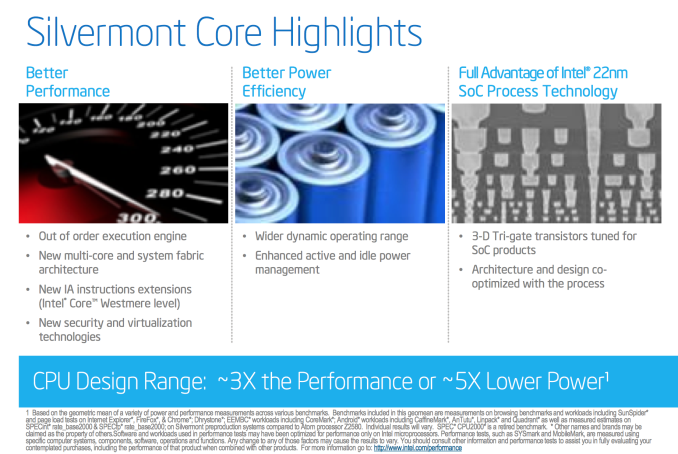
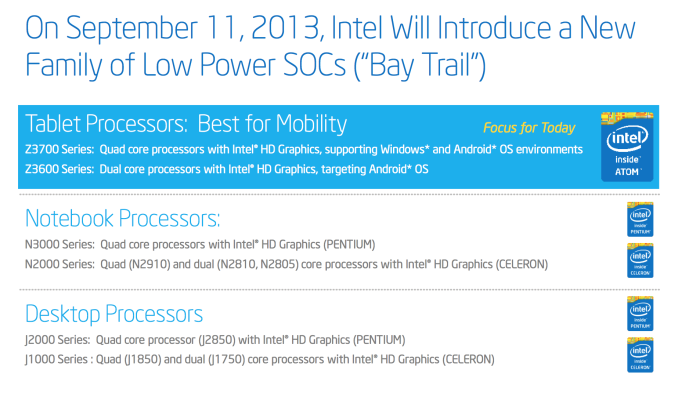
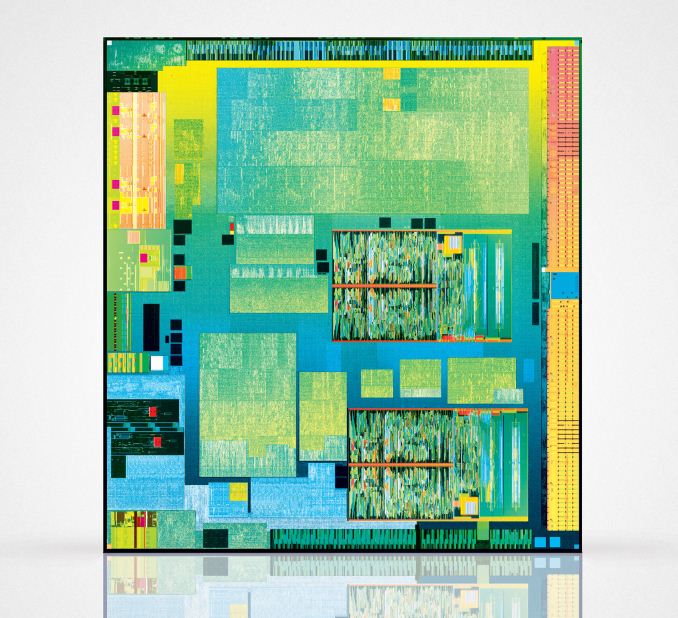
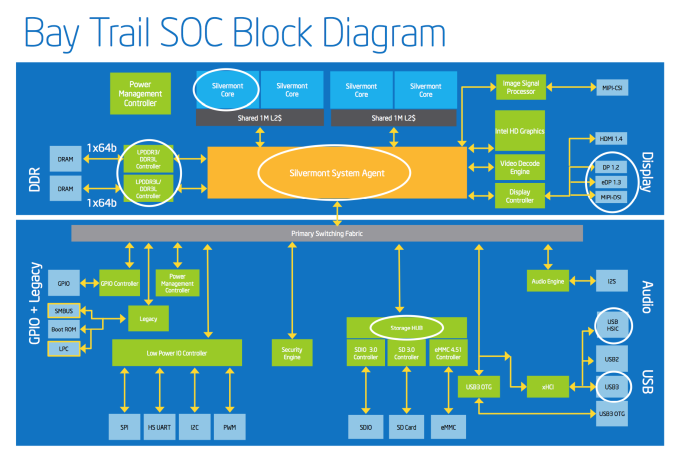
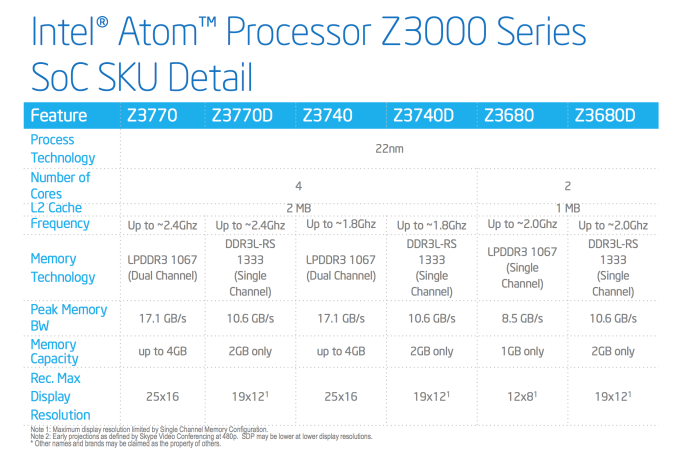
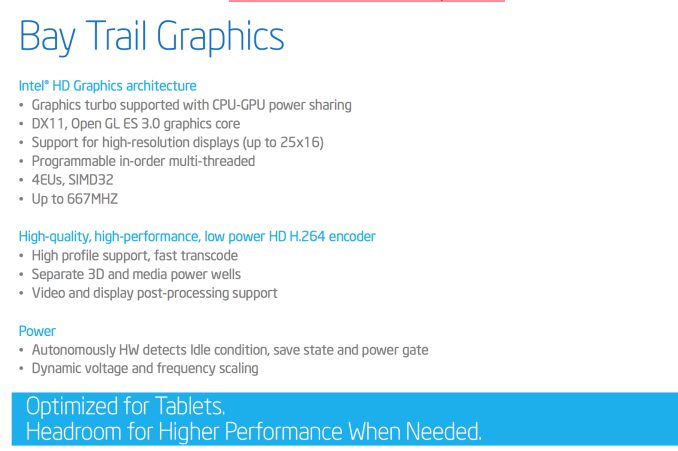
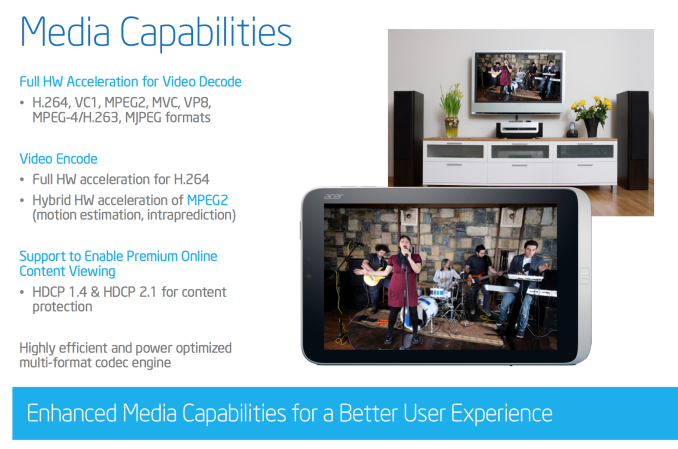








190 Comments
View All Comments
Dentons - Wednesday, September 11, 2013 - link
Whether Intel's chips are "only" 50% more expensive or 100% more expensive, why would that motivate a move to Intel? What's the advantage? A 5% performance gain? That's not a motivator. Especially considering the considerable advantages of ARM. With ARM, tablet builders can purchase CPU's from a multitude of manufacturers. With X86, that competition would be non-existent.Were Intel to have a 50% or 100% performance advantage, some manufacturers might be enticed, at least for their higher end products, but that's not where we are. As things stand now, only those manufacturers needing X86 compatibility are likely to bite. The only need for X86 is Windows. So other than the handful of Android tablets that Intel pays to have built, all of these chips will go into Windows 8 machines. Likely 99% + of shipping volume.
This is a chip designed to prolong the WinTel duopoly. That is this chip's best case scenario. It's going to have almost no real-world uptake in Android and absolutely no uptake on iOS. Its intrusion into the mobile ecosystem will, at best be 5% to 10%.
This is small time.
rabidkevin - Friday, September 13, 2013 - link
"The only need for X86 is Windows."Last time I checked, x86/x64 is used for windows, linux, mac osx, ps4 and xbox one.
Dentons - Tuesday, September 17, 2013 - link
To clarify, I was referring to this specific chip, not X86 in general. Were I being overly precise, I'd have written "The only significant market need for this particular, mobile-specific, low-power X86 chip is Windows."It's hard to see any of the other markets you've mentioned needing, wanting, or using these chips. That's a massive problem for Intel, as right now, the tablet market is almost entirely iOS and Android. For iOS and Android, X86 compatibility is at worst a significant liability, at best, a completely unneeded expense.
It seems unlikely Intel will see much uptake with Apple or Android manufacturers. How else can Intel gain traction in the Tablet market if not with Windows? And that, as we know, requires the Microsoft tax, pricing Intel well out of the current tablet market.
Intel's in a tough spot. While they have finally released a chip with power / performance parity to ARM's latest, it may be 5 or 6 years too late.
Kidster3001 - Thursday, September 12, 2013 - link
All of your arguments apply to the Home PC market in 1980 where Intel had zero market share. What happened in the next decade?All of your arguments apply to the Server market in 1990 where Intel had zero market share. What happened in the next decade?
All of your arguments apply to the Supercomputer (HPC) market in 2000 where Intel had zero market share. What happened in the next decade?
I wouldn't be so quick to count Intel out in the long run.
ancientarcher - Friday, September 13, 2013 - link
I think the same thing that Intel did to the RISC based processors in the 1980s, 90s and 2000s will be done to it by ARM. Disruption from below, my friend.and what did happen - first you say the competition is cheap and low quality (on whatever metrics) and ignore it. then you say the same thing, but secretly tool up to compete (which takes a few years), in the meantime, the cheap but good-enough parts are improving much faster than you are. The reason you take time to compete is because you don't see much money there and by corporate style IRR calculations it doesn't make sense to compete. By the time you are ready to compete (which takes many years, 5-6 in the case of Intel), the erstwhile cheap and bad competition has become cheap and competitive and finally cheap and good, then better. Then you die.
Watch and see what happens to Intel in 3-4 years...
MyOpinionDoesNotMatter - Saturday, September 14, 2013 - link
Intel dead in 3-4 years??? I Hope ARM chip manufacturers take the Intel threat more seriously than you do. Intel have the resources and now (finally) the mobile focus to one day have a monopoly...for the sake of us consumers I hope ARM chips can remain competitive in the long run. Intel have caught up a lot in Bay Trail and this will make the next generation of chips very interesting. We may end up with a situation similar to Intel/AMD in high TDP chips....Intel for high performance mobile/tablets and ARM chips for the low end.jhoff80 - Wednesday, September 11, 2013 - link
I know that this is slightly off topic, but I was under the false impression that Connected Standby would be coming to 8.1 even on the architecture. Are there any plans whatsoever to bring that feature?It's not a huge deal, but it'd be nice for Skype calls or even for Windows 8.1's new "Alarms" app to have that support. It actually makes the idea of upgrading to a Haswell tablet from my Surface a bit less appealing.
zeo - Wednesday, September 11, 2013 - link
Connected Standby is supported and has been support, it's only new for Intel's higher end process but Haswell will bring that support to the Core processor... The ATOM SoCs already had it... It just requires both the OS, system firmware, and hardware support to work...If anything is off, like bad wifi drivers, then it won't work correctly...
jhoff80 - Thursday, September 12, 2013 - link
Well, first of all, that was supposed to say "I was under the false impression that Connected Standby would be coming to 8.1 even on the x64 architecture."Secondly, what I'm referring to is the quote from the article: "Although the core architecture is 64-bit in design, there will be no OS support for 64-bit Bay Trail at launch. Windows 8.1 with Connected Standby appears to still be 32-bit only"
I'm completely aware that it depends on every part of the chain and that support for it is now available in Haswell, but that doesn't do much if I can't use all of my 4 or even 8GB of RAM with that fancy new chip.
UNCjigga - Wednesday, September 11, 2013 - link
Sounds like the ideal platform for a sub-$200 Chromebook, but I'm still wary of Windows 8.1 performance.